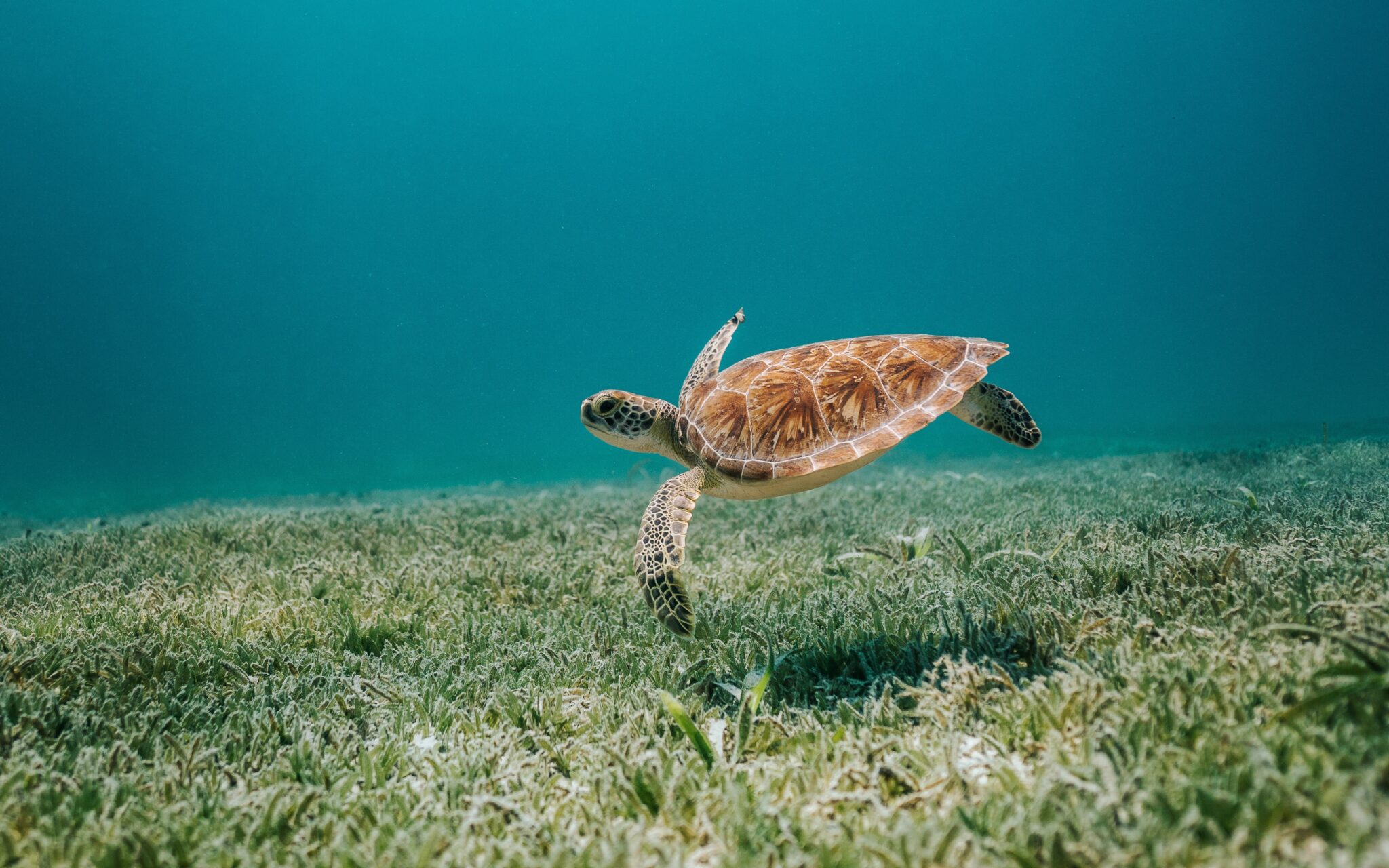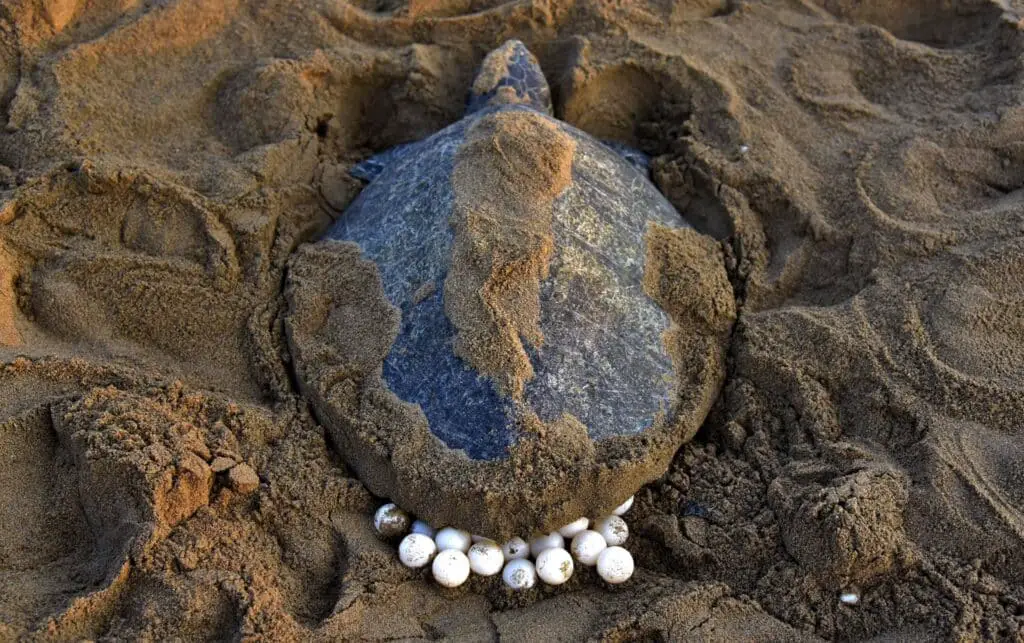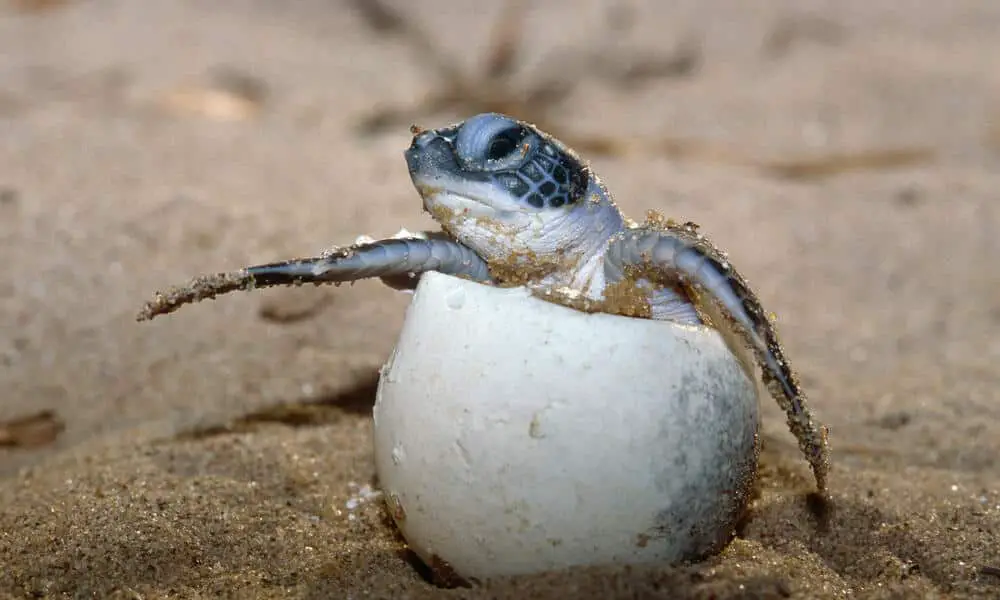How Many Eggs Do Sea Turtles Lay

Introduction
How Many Eggs Do Sea Turtles Lay: Sea turtles, magnificent and ancient creatures, have been gracing the world’s oceans for millions of years. These gentle giants, descendants of prehistoric reptiles, capture our imaginations with their graceful movements beneath the waves and their epic journeys across vast oceanic distances. However, there is a lesser-known aspect of sea turtle life that is equally remarkable and crucial for their survival: their reproductive habits.
Sea turtles undertake an extraordinary annual pilgrimage to nesting beaches, where they engage in a profound and delicate ritual. Female sea turtles, often traveling thousands of miles, return to the very beach where they themselves hatched. With a deep instinctual drive, they dig nests in the sand and deposit their precious cargo of eggs. This process is a critical link in the life cycle of these creatures, but it also presents numerous challenges and mysteries.
In this exploration, we will delve into the fascinating world of sea turtle nesting. We will uncover the astonishing diversity in the number of eggs laid by different species of sea turtles and the factors that influence this variation. We will also discover the ecological significance of sea turtle eggs and the ongoing conservation efforts to protect these ancient mariners.

How many eggs does a sea turtle lay each time?
In a single nesting season, females lay between two and six clutches of eggs, each containing 65 to 180 eggs. The clutches are laid approximately every two weeks, and the period between female nesting season ranges from one to nine years.
Sea turtles, ancient and enigmatic beings, lay varying numbers of eggs in each nest they meticulously craft on sandy shores. The exact quantity hinges on several factors, chiefly the species of sea turtle. The smallest among them, the Kemp’s ridley, typically lays the fewest eggs per nest, numbering around 100, whereas loggerhead turtles often deposit larger clutches, averaging around 120 to 150 eggs. Leatherback turtles, the largest and most colossal of their kind, can lay the fewest eggs per nest, typically ranging from 70 to 100.
Environmental conditions also play a role in determining the number of eggs. Factors like the turtle’s age, health, and nutrition, as well as the quality of the nesting site, can influence the clutch size. Sea turtles usually nest multiple times during a single nesting season, with an interval of about two weeks between each nesting event. This provides them with multiple opportunities to contribute to the next generation.
The quantity of eggs laid by sea turtles is a product of millennia of evolution, adaptation, and survival strategies honed to ensure the continuation of these incredible marine reptiles. Understanding the intricacies of their nesting habits is not only a testament to their resilience but also a crucial step in their conservation and the protection of the delicate ecosystems they inhabit.
Do turtles lay 100 eggs?
The sea turtle lays up to 100 eggs, which incubate in the warm sand for about 60 days. The temperature of the sand determines the genders of baby sea turtles, with cooler sand producing more males and warmer sand producing more females.
Turtles do not universally lay exactly 100 eggs; rather, the number of eggs a turtle lays can vary significantly depending on the species and other factors. Turtles belong to a diverse group of reptiles with a wide range of reproductive strategies and clutch sizes.
Some turtle species, like the Kemp’s ridley sea turtle, are known for laying around 100 eggs per nest. However, this is not a fixed number for all turtles. Other sea turtle species, such as the loggerhead, often lay larger clutches, with an average of 120 to 150 eggs per nest. Conversely, there are terrestrial and freshwater turtle species that lay smaller clutches. For example, box turtles typically lay clutches containing 1 to 7 eggs, while painted turtles may lay clutches ranging from 4 to 20 eggs.
The number of eggs a turtle lays is influenced by various factors, including the species, age, health, size, and environmental conditions. These differences in clutch size have evolved over time to suit the specific needs and survival strategies of each turtle species in its respective habitat.
While some turtle species may lay around 100 eggs per nest, there is significant variation in clutch sizes among different turtle species, making the number of eggs laid by turtles a diverse and species-specific characteristic.
Why do sea turtles lay 100 eggs?
On average, depending on the age of the turtle and the species, the female sea turtle will lay between 50-100 eggs. This large number ensures increased survival rates for the population.
One of the primary factors influencing the number of eggs sea turtles lay is the high mortality rate faced by their hatchlings. Sea turtle hatchlings are incredibly vulnerable to predation, both in the nest and during their perilous journey to the sea. By laying a relatively large number of eggs, sea turtles increase the chances that at least some of their offspring will survive to maturity.
This strategy helps compensate for the considerable threats and challenges that sea turtle hatchlings encounter, from predators like crabs and birds to environmental hazards such as beach erosion and pollution.
Additionally, sea turtles have evolved to reproduce multiple times within a nesting season, typically with a gap of about two weeks between nests. This further increases their chances of producing offspring that will reach adulthood.
Sea turtles lay a considerable number of eggs, not exactly 100 but varying depending on the species, to maximize the survival of their young in the face of numerous threats and uncertainties in their natural environment. This strategy has been honed through millions of years of evolution and is crucial for the continuation of these magnificent marine reptiles.
How many eggs does a normal turtle lay?
Depending on the species and size of the turtle, a clutch will contain between 80-180 eggs. The largest sea turtle—the Leatherback turtles—lay approximately 110 eggs per clutch. Meanwhile, the Hawksbill turtles produce the largest clutches, with up to 140-160 eggs in a nest!
The number of eggs laid by a normal turtle can vary widely depending on the species. There are hundreds of different turtle species around the world, and each has its own unique reproductive habits. Generally, turtles are known to lay a clutch of eggs rather than a single egg, which increases the chances of some offspring surviving to adulthood.
For example, common snapping turtles, found in North America, typically lay between 20 to 40 eggs in a single nest. Painted turtles, another North American species, may lay around 4 to 20 eggs per nest. Box turtles, also found in North America, lay smaller clutches, usually consisting of 1 to 7 eggs.
In contrast, sea turtles, which are a type of marine turtle, can lay larger clutches. The specific number of eggs varies among sea turtle species. For instance, Kemp’s ridley sea turtles typically lay around 100 eggs per nest, while loggerhead turtles may lay 120 to 150 eggs in a nest.
The number of eggs a turtle lays is influenced by factors such as the turtle’s age, size, health, environmental conditions, and evolutionary adaptations. Each species has evolved its own reproductive strategy to optimize the chances of its offspring’s survival in its particular habitat and ecological niche.
How many eggs do turtles carry?
Depending on the species and size of the turtle, a clutch will contain between 80-180 eggs. The largest sea turtle—the Leatherback turtles—lay approximately 110 eggs per clutch. Meanwhile, the Hawksbill turtles produce the largest clutches, with up to 140-160 eggs in a nest!
Turtles don’t carry eggs inside their bodies like mammals do; instead, they lay eggs externally. When it comes to reproduction, female turtles dig a nest in the ground and lay their eggs there. The number of eggs a turtle carries, or rather lays, varies significantly among different turtle species.
For instance, terrestrial turtles like the box turtle typically lay smaller clutches of eggs, ranging from 1 to 7 eggs per nest. Aquatic turtles such as the painted turtle may lay slightly larger clutches, usually consisting of 4 to 20 eggs. In contrast, sea turtles, which are marine turtles, can lay even larger clutches. The number of eggs laid varies by sea turtle species, with Kemp’s ridley sea turtles typically laying around 100 eggs per nest, while loggerhead turtles may deposit between 120 to 150 eggs in a single nest.
The number of eggs a turtle lays is influenced by a variety of factors, including the turtle’s species, age, size, health, environmental conditions, and evolutionary adaptations. These factors have evolved over time to optimize the survival chances of the turtle’s offspring in their specific habitats and ecological niches. Overall, while the number of eggs laid by turtles varies, it is a crucial part of their reproductive strategy to ensure the continuation of their species.
How can I help protect sea turtle eggs and hatchlings?
Protecting sea turtle eggs and hatchlings is crucial for the survival of these ancient marine creatures. There are several practical steps individuals can take to make a positive impact. Firstly, it’s vital to support and participate in conservation efforts. This includes volunteering with organizations dedicated to sea turtle protection, contributing to research, and advocating for legislation that safeguards their nesting habitats.
Another key measure is to minimize human disturbance on nesting beaches. This involves avoiding the use of artificial light near nesting sites, as it can disorient hatchlings and deter nesting females. Additionally, refraining from beachfront construction and keeping a safe distance from nesting turtles helps maintain their natural environment.
Promoting responsible tourism is equally important. Encouraging practices like not touching or riding on turtles during nesting season and participating in guided tours led by certified eco-friendly operators can help ensure a positive impact on their fragile ecosystems.
Supporting the enforcement of laws against poaching and illegal trade of sea turtle products is crucial. Reporting any suspicious activities related to turtle poaching or egg collection can help authorities take action against these harmful practices.
Ultimately, every action, no matter how small, contributes to the collective effort of protecting sea turtle eggs and hatchlings. By raising awareness, supporting conservation initiatives, and adopting responsible behaviors, we can make a tangible difference in the preservation of these magnificent creatures and their habitats.
Are there conservation efforts to protect sea turtle eggs and hatchlings?
There are extensive conservation efforts in place worldwide to protect sea turtle eggs and hatchlings. These initiatives are crucial in ensuring the survival of these ancient marine species. Conservation organizations, government agencies, and local communities collaborate to implement various strategies.
One primary focus is the identification and protection of nesting sites. Conservationists work tirelessly to monitor and safeguard beaches where sea turtles lay their eggs. This includes the installation of protective barriers, nest relocation when necessary, and the implementation of strict regulations to limit human interference.
Additionally, educational programs play a vital role in raising awareness about the importance of sea turtle conservation. These programs engage local communities, tourists, and school children, fostering a sense of responsibility and appreciation for these magnificent creatures.
Research is another critical component of conservation efforts. Scientists study sea turtle behavior, migration patterns, and nesting habits to gain valuable insights that inform conservation strategies. This research helps identify high-priority areas for protection and allows for the development of effective management plans.
Overall, the collective efforts of conservation organizations, researchers, governments, and communities worldwide are instrumental in the ongoing endeavor to protect sea turtle eggs and hatchlings, ensuring a brighter future for these remarkable creatures.
How often do sea turtles nest and lay eggs?
Sea turtles exhibit a remarkable nesting behavior, typically returning to coastal areas to lay their eggs every two to three years. The frequency of nesting, however, can vary among different species. For instance, loggerhead turtles tend to nest every two to three years, while green turtles may nest every two to four years. Leatherback turtles, on the other hand, have more irregular nesting intervals, often spanning several years.
Within a nesting season, which typically lasts from late spring to early summer, a female sea turtle may lay multiple clutches of eggs. These clutches are separated by intervals of approximately two weeks, allowing the turtle to regain strength before returning to the beach for another nesting episode.
It’s worth noting that the nesting process itself is a meticulous and physically demanding task for the female turtle. After selecting a suitable nesting site, she excavates a nest cavity using her flippers, then deposits a clutch of leathery eggs, which can range from 50 to over 100, depending on the species. Once the eggs are laid, the female carefully covers the nest and returns to the ocean.
This reproductive strategy, coupled with conservation efforts to protect nesting sites, plays a vital role in the continued survival of sea turtle populations around the world.

Conclusion
Exploring the question of how many eggs sea turtles lay has unveiled a captivating dimension of these remarkable creatures’ lives. As we conclude our journey into the world of sea turtle nesting, several key insights emerge.
Firstly, we’ve learned that sea turtles exhibit a remarkable diversity in their nesting behaviors. Some species, like the Kemp’s ridley, lay relatively few eggs in each nest, while others, such as the loggerhead and leatherback, may deposit larger clutches. This variability is a result of evolutionary adaptations to specific environmental conditions and survival strategies.
Secondly, we’ve recognized the ecological significance of sea turtle eggs. They serve as a vital link in marine food webs, providing sustenance for numerous predators, including crabs, birds, and mammals. This ecological interdependence underscores the importance of protecting sea turtle nesting habitats.
Lastly, we’ve witnessed the ongoing conservation efforts aimed at safeguarding sea turtles and their nests. Conservationists, researchers, and communities worldwide are working tirelessly to mitigate threats such as habitat destruction, pollution, and poaching, which imperil these ancient mariners.
Understanding how many eggs sea turtles lay is not just a matter of scientific curiosity; it’s a reflection of the delicate balance of life in our oceans. It reminds us of our shared responsibility to protect these magnificent creatures and their nesting sites, ensuring that sea turtles continue to grace our seas for generations to come.



